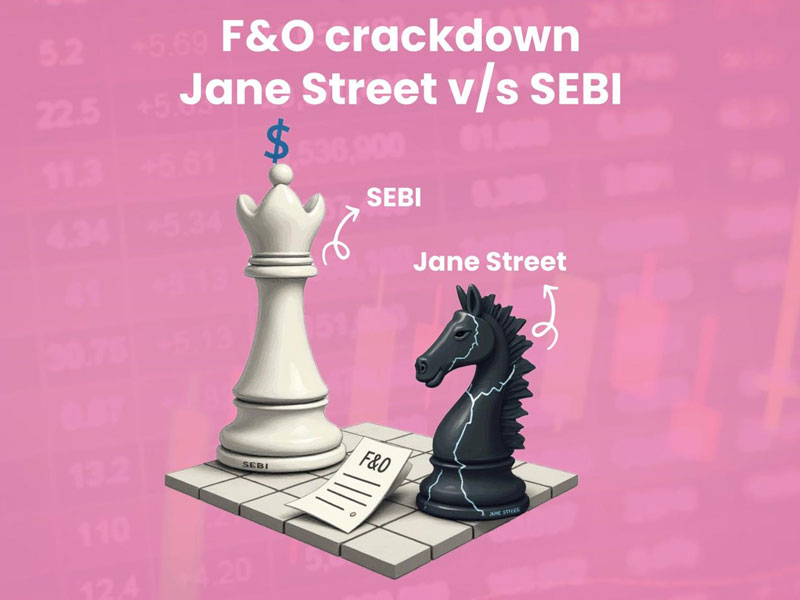Jane Street Scam Teaches Retail Investors: Play The Game You Can Win

While investigating the New York-headquartered quantitative trading firm, Jane Street Capital, the market regulator revealed an illegal profit of over Rs 4,000 crore.
Securities and Exchange Board of India (SEBI) alleged that Jane Street and its affiliated entities took huge derivatives positions to manipulate the Bank Nifty index. The order stated that Jane Street made illegal gains of Rs 4,843 crore through short-term trades.
The market watchdog has imposed a sweeping ban on Jane Street, prohibiting it from participating in the India stock market. Moreover, SEBI has also directed to seize the illegal gains of Rs 4,843 crore.
How Jane Street Manipulated Nifty Bank Index
SEBI found a repeated pattern in Jane Street trading style which indicated that those were not normal trades but were manipulation of Bank Nifty index and violation of prohibition of fraudulent and unfair trade practice rule. Jane Street and its entities were not engaged in medium to long-term trades, rather their strategy was to make profits from short-term high frequency trading (HFT).
Jane Street used to make large purchases of Bank Nifty futures and stocks related to Bank Nifty in the morning. At the same time, they would sell a lot of Bank Nifty options. In the afternoon, especially on expiry days, they would start selling huge amounts of Bank Nifty futures to push the index in a particular direction and influence how it closed for the day.
For example, on the morning of 17 January 2024, Jane Street bought Bank Nifty futures worth Rs 4,370 crore and sold Bank Nifty options worth Rs 32,115 crore. After noon, it started selling a large amount of Bank Nifty futures again worth Rs 5,372 crore.
This created a big short position of Rs 46,620 crore in Bank Nifty options. As a result, the Bank Nifty index closed lower. Jane Street made a profit of Rs 735 crore from options trading but faced a small intraday loss of Rs 61.6 crore in cash and futures. Overall, it made a net profit of Rs 673.4 crore on that expiry day.
What is HFT Trading?
High-frequency trading (HFT) is a mode of buying and selling stocks through using powerful computers and smart algorithms. These computers can make thousands of trades in just a few seconds, much faster than any retail trader can.
The goal of HFT is to make small profits on each trade by reacting to market changes very quickly. Even though the profit on one trade might be tiny, doing it thousands of times a day can add up to a lot of money.
In simple words, HFT is like using super-fast robots to trade in the stock market and make quick profits by being faster than everyone else.
Learn Or Loose: MINITIT Advice To Retail Investors
● When giants like Jane Street manipulate the markets using high-frequency trading (HFT), it proves one thing— retail investors are playing a rigged game in short-term trading. But with SIPs and mutual funds, you can win the long game.
● Trading is not only risky, but it is surely a losing game when retail investors are outpaced by powerful entities using advanced tools which are beyond retail investors’ reach.
● Retail traders can’t beat big sharks in this game but they can beat inflation, taxation, financial prison and volatility over time with disciplined and consistent investments in mutual funds.
● Retail traders can’t match speed but retail investors can craft short and long-term strategies for their goals unders the right guidance. Patience over panic, discipline over drama.
Decreasing Addiction of Trading
SEBI in the past has also made various attempts to curb speculative trading. A report by SEBI revealed that 9 out of 10 traders face losses. Along the way Sebi removed multiple expiry dates by exchanges, capped F&O investing etc.
Also, the business update from Angel One reported that its gross client acquisition fell 41.5% year-on-year (YoY) in June 2025. The average daily order also dropped from 8.84 million to 5.79 million YoY in June. Whereas, the average daily turnover on a notional basis fell 23.5% YoY to Rs 35 lakh crore.
This change indicates the decrease in intraday and derivatives trading after campaigns by the market regulator to curb speculative loss by amateur retail traders.
Revolution In Mutual Funds Industry: A Changing Landscape
On the one hand, trading seems to be reduced, the SIPs have increased to an all-time high at Rs 26,688 crore in May as more retail investors are encouraged towards long-term investing instead of short-term profits and an unmatched competition from big entities who have advantages of HFT.
Moreover, the mutual fund industry recorded an overall inflow of Rs 29,108 crore in May and the assets under management (AUM) rose 4.85% and stood at the record-peak of Rs 72.2 lakh crore compared to Rs 70 lakh crore in May.
To start your journey towards long-term wealth creation, India's mutual funds dedicated platform, MINTIT, is committed to handhold through this journey. MINTIT, with its expert guidance, suggests tailored mutual fund plans to achieve your goals with no haste.
- Indian Markets End July On A Volatile Note Amid Global Uncertainty and Tariff Woes
- Laal Street & Tariffs War; Let’s Understand
- Market In May; Mid & Small caps Emerge Winners
- Market Victory in June; Q1 Earnings & Judgement Day at the Door
- A Monthly Recap of Cool April - 2025
- Gold At All-time High
- From Tariffs to Trends: Decoding India’s August Market Moves
- The ₹88 Lakh vs ₹17 Crore Dilemma: Numbers Reveal the Truth
- Jane Street Scam Teaches Retail Investors: Play The Game You Can Win
